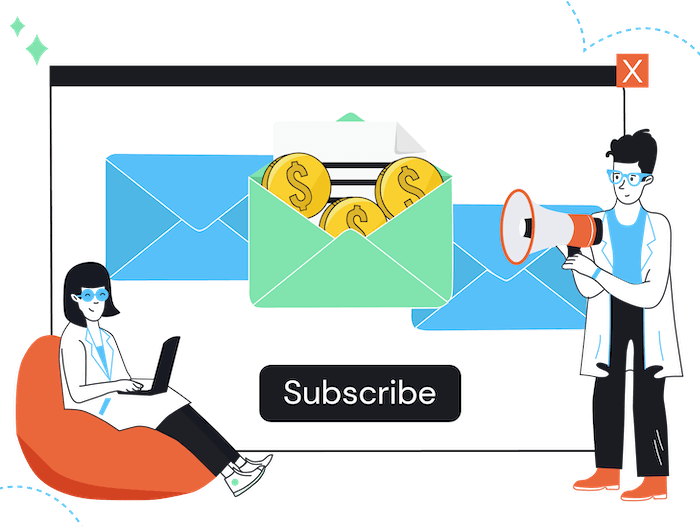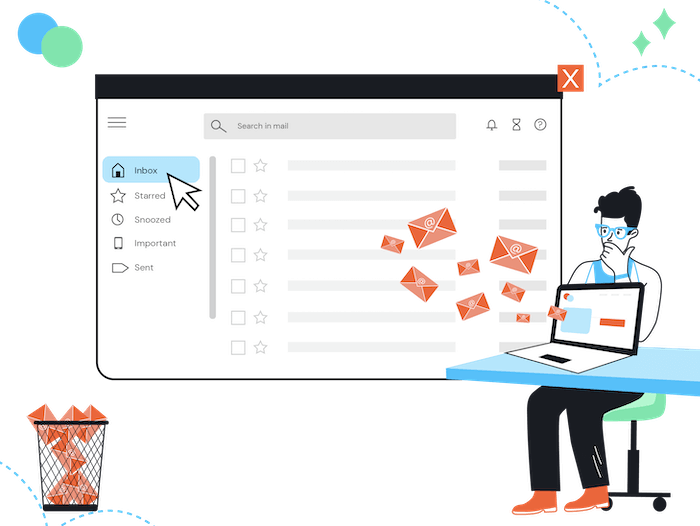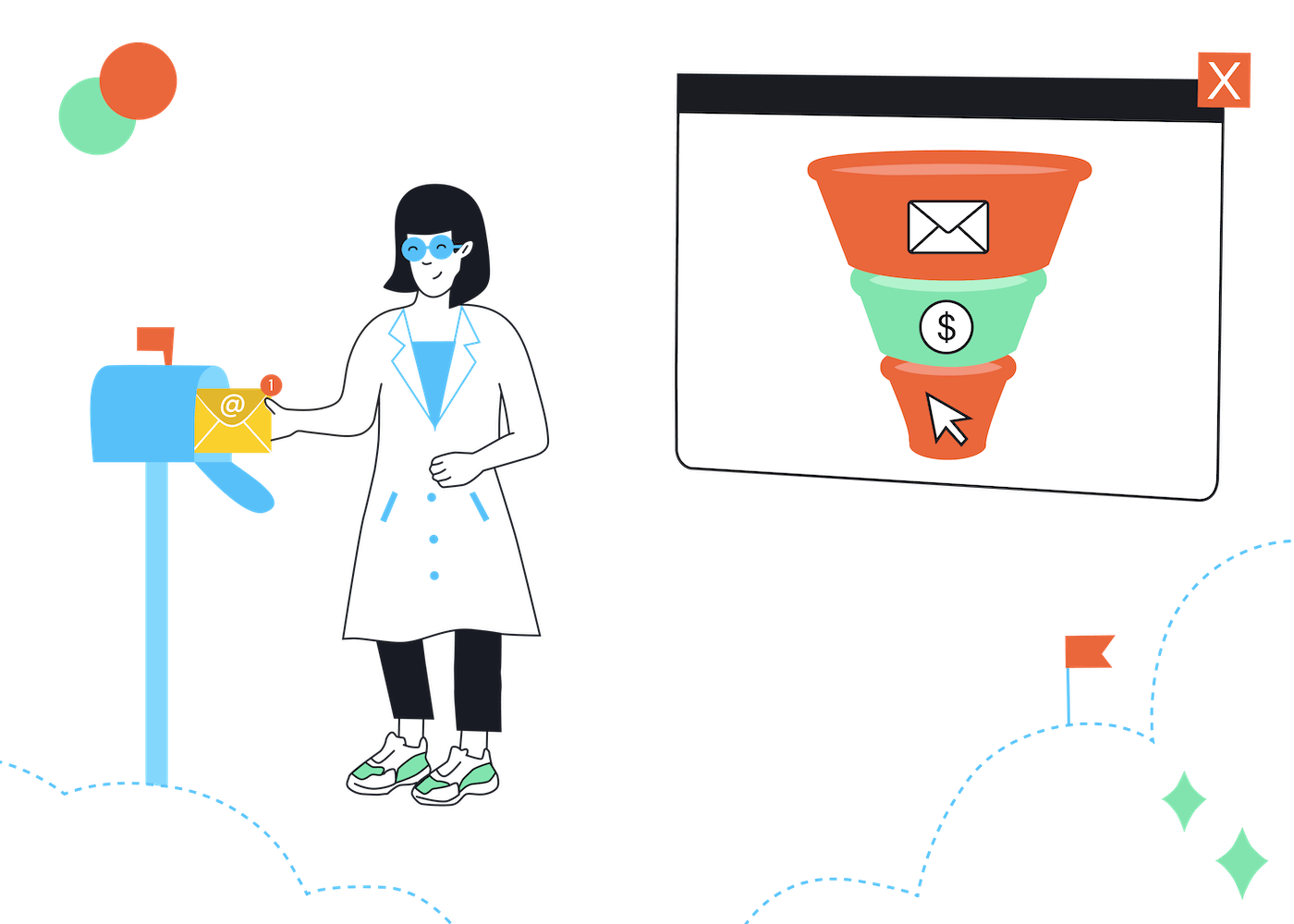If you spend any time on the internet at all, you might have noticed how email newsletters are all the rage in marketing lately. Perhaps you're just starting to explore this channel for your own business, and are looking for ways to connect with your audience more effectively.
You may have heard that newsletters can boost brand awareness and drive engagement, but you're not quite sure where to start. How do you create a newsletter that stands out? How can you make it compelling enough to get opened, read, and acted upon amidst the countless emails your audience receives?
If these are the kind of questions that brought you here, you're in the right place. I'm going to walk you through how a well-planned newsletter marketing strategy can help you meet your marketing goals.
In this blog post, you'll learn how to kick-start your email newsletter marketing the right way. From understanding the basics to exploring advanced strategies, you'll get all the tools and insights you need to refine your newsletters and achieve extraordinary results. So, let's dive in!
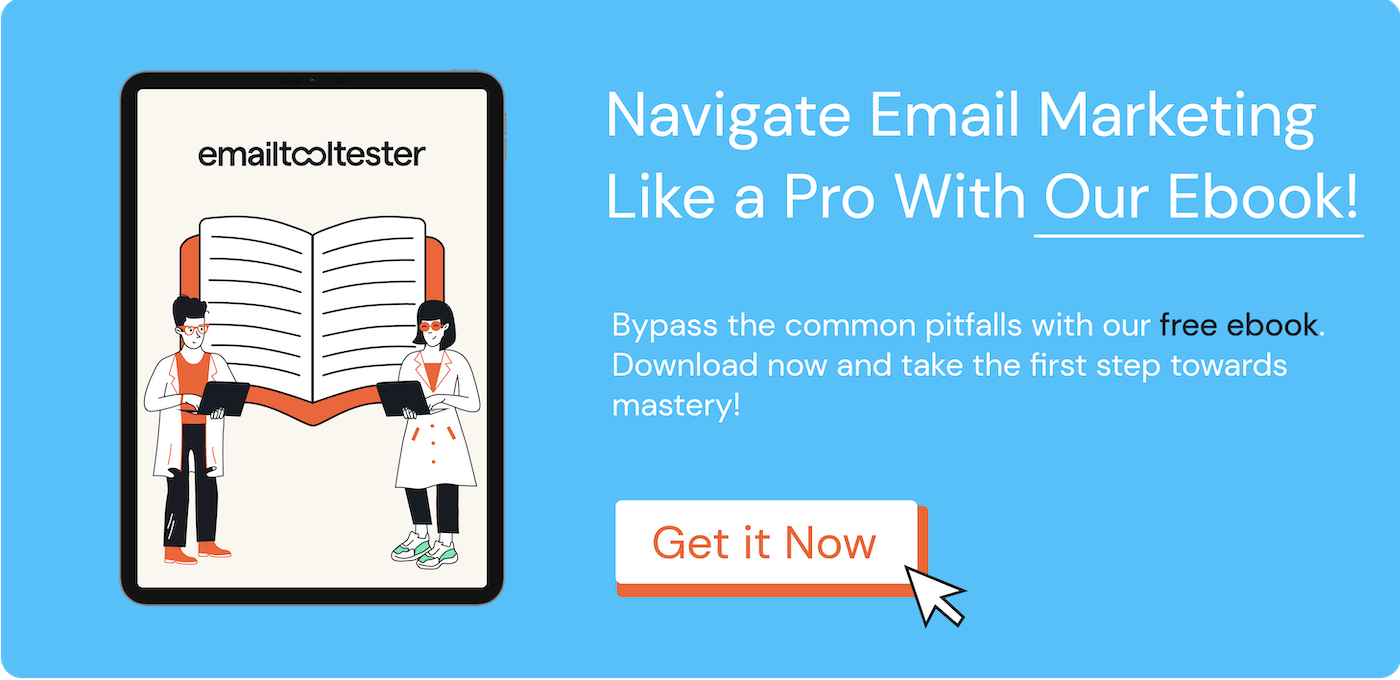
What is Newsletter Marketing?
Isn't it awesome when you get an email that isn't just trying to sell you something – but actually has great, useful content? That's what newsletter marketing is all about. Imagine it as your recurring check-in with your audience, dropped right into their inbox as often as you (or they) choose – daily, weekly, or monthly.
The charm of newsletters is their consistency, creating a familiar format your readers will grow to anticipate. The key isn't to push products or services but to share valuable tidbits your readers will appreciate. You can tell a compelling story and include updates, educational materials, insights into industry trends, upcoming events, or even content curated from other places.
Newsletters can help foster a sense of community, deepening connections with your audience, and encouraging interaction. This makes them an understated but powerful tool in your marketing toolbox. Aside from increasing brand awareness and building a loyal community, a well-crafted newsletter can subtly steer your audience to your latest blog post, event, or anything you want to highlight.
And guess who benefits from sending these newsletters? It's a broad range, from businesses to freelancers, nonprofits, content creators – you name it! Because their format is so easy and customizable, newsletters have the power to fit into every marketing strategy out there.
So, regardless of your niche – whether that's ecommerce, restaurants, real estate, or anything else! – you can think of newsletters as your friendly conversation starter, helping you achieve your marketing goals one email at a time.
How Is Newsletter Marketing Different than Other Email Marketing Strategies?
The secret ingredient that sets newsletter marketing apart from other email marketing strategies is its emphasis on providing valuable content to the reader. Newsletter marketing aims to create a unique connection with your audience – the idea is for it to not feel like just another ad.
By regularly offering content that is both informative and engaging, your audience will be interested in what you have to share – even if they're not immediately interested in making a purchase. The results come over time.
Other marketing emails, such as promotional emails, transactional emails, or automated emails (like cart abandonment emails in ecommerce) are often more sales-focused. These are designed to drive a specific action, like making a purchase, completing a form, or participating in a particular event.
Just check out these two email examples. One of these is a newsletter, and the other is an automated email – can you tell which is which?
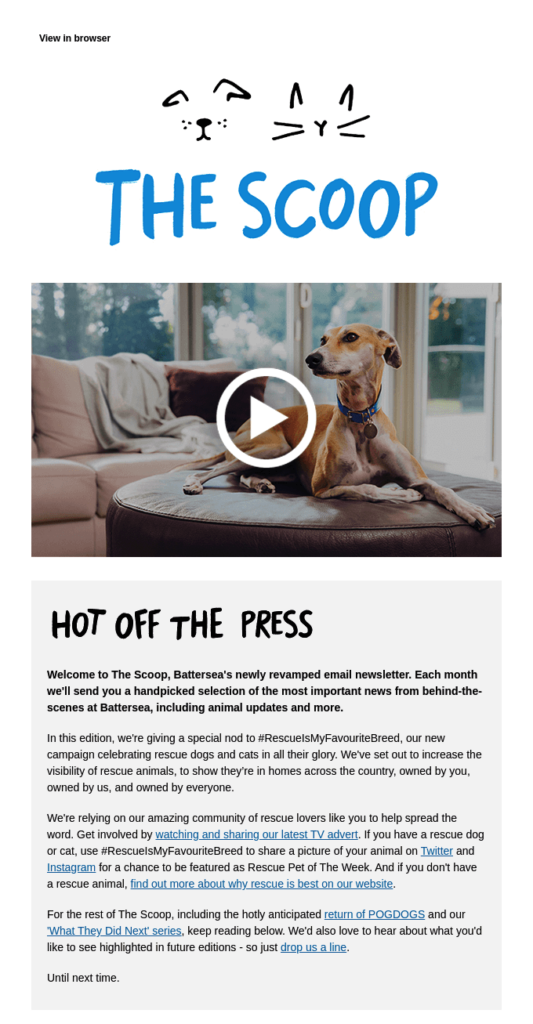
Sources: Battersea Dogs and Cats Home on Really Good Emails

Source: DutchBros on Really Good Emails
As you can see, with newsletters (like the Battersea Cats and Dogs example), the focus tends to be on sharing news, offering insights, delivering curated content, or giving access to exclusive resources. This content-first approach allows your business to be perceived as a trusted source of information, making subscribers more likely to engage with your brand when the time comes to make a purchase.
Crafting a great newsletter requires a combination of skills, including stellar writing, eye-catching design, and, of course, strategic planning. But remember: the goal with a newsletter is not just to sell, but to create a unique experience for your subscribers that keeps them coming back for more.
Can A Newsletter Marketing Strategy Really Make a Difference to My Business?
Short answer? Absolutely! With the digital landscape becoming more and more competitive, businesses need to find smarter ways to truly connect with their target audience. Successful newsletter marketing can help foster strong customer relationships and that is key to elevating brand awareness, and ultimately driving sales.
The numbers speak for themselves. The return on investment for newsletters is astounding. Email marketing can deliver an ROI of between $32-$45 for every $1 spent, depending on your industry. And with 90% of Americans subscribed to at least one newsletter, this marketing channel holds tremendous potential for businesses looking to expand their reach and drive conversions.
To stay ahead in 2024, businesses need to incorporate email newsletter marketing as part of their overall marketing strategy. By focusing on creating relevant content, optimizing subject lines, and delivering a seamless experience across both desktop and mobile devices, you can maximize the impact of your newsletters and build a perfect path to achieving your marketing goals.
Ready to get started? I’ll show you exactly how to do all that in the next section.
Building a Comprehensive Newsletter Marketing Strategy
There are several components to a newsletter marketing strategy, and each of these will play a vital role in your newsletter's success. By aligning all aspects of your strategy, you'll be able to create newsletters that resonate with your audience and drive tangible results for your business.
Let's delve into each of these components and explore how exactly they can elevate your newsletter marketing to new heights.
1. Defining Your Target Audience
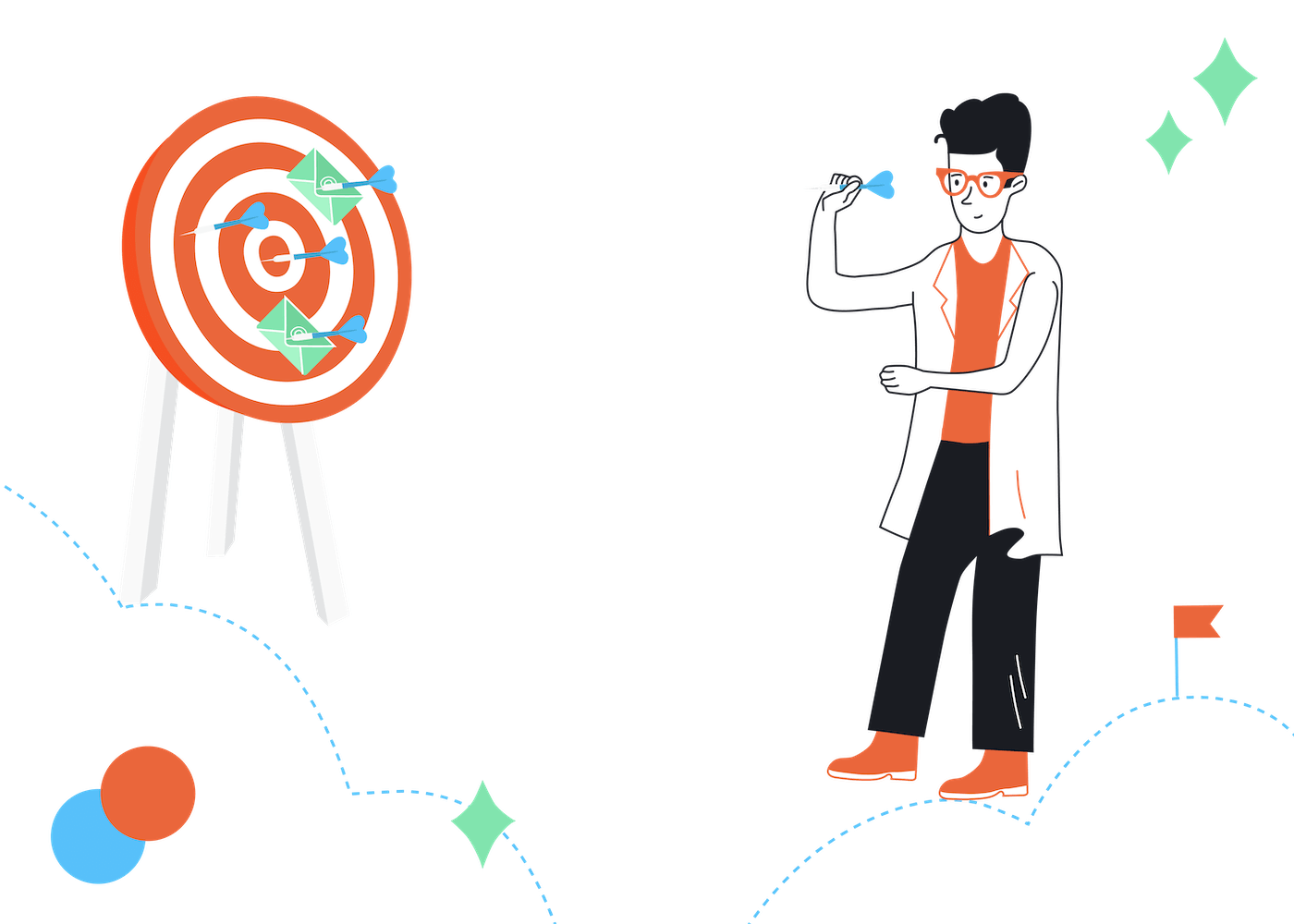
Understanding and defining your target audience is a crucial first step in crafting a successful newsletter marketing strategy. By knowing who your audience is and what interests them, you can tailor your content to their needs and preferences and send newsletters that hit the mark every time.
To define your target audience, start by analyzing your existing customers. Look for patterns in their demographics, interests, and behaviors. This will give you valuable insights into who you should be targeting with your newsletters and what kind of content they would love to receive in their inbox. You can even refine this research using the newsletter itself, by sharing a poll and asking for feedback (more on that later!).
Remember, the more relevant your content is to your target audience, the more likely they are to engage with your brand, spread the word and become loyal customers.
2. Crafting Compelling Subject Lines

Which of these subject lines entices you to open the email? Different strategies will work for different audiences
The email subject line is the first thing your subscribers see when they receive your newsletter. Needless to say, it is a critical component of your email marketing strategy. A well-crafted email subject line can make the difference between an opened email and one that's ignored or sent to the spam folder.
If you want to nail subject lines, keep them short and sweet, ideally under 50 characters. Make sure they're personalized, relevant, and prompt the reader to take action. A good subject line should pique the reader's curiosity and give them a reason to open your newsletter.
Don't be afraid to get creative with your subject lines. Play a little with format and style until you find what resonates best with your audience. Remember to track your open rates and use this data to inform your future subject line choices. In doing so, you’ll find that refining subject lines will become an easier task over time.
3. Designing Visually Appealing and Mobile-Friendly Newsletters
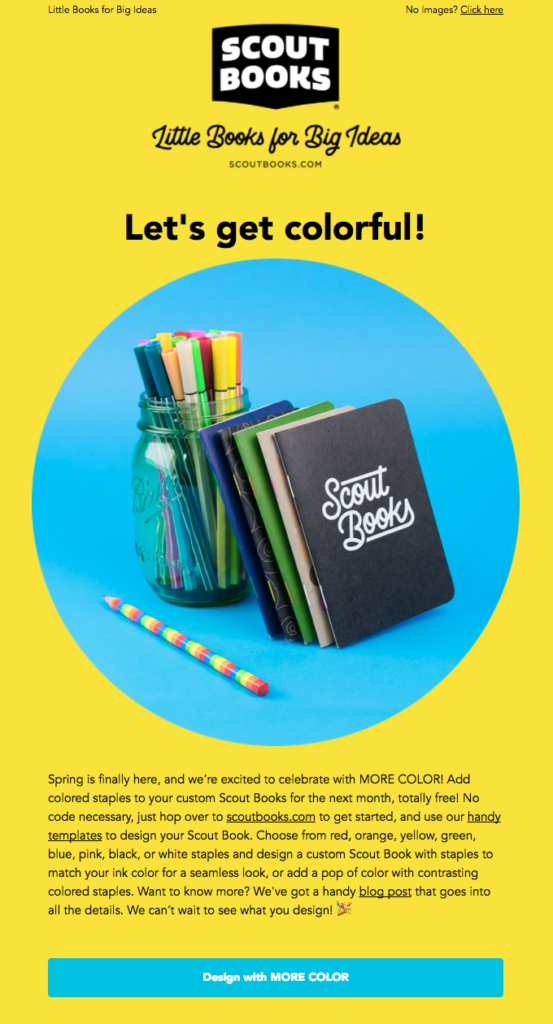
An eye-catching newsletter design can make all the difference, as you can see in this newsletter example from Scout Books (Source: Really Good Emails)
First design impressions matter a lot in the newsletter world. A visually appealing and well-structured newsletter is much more likely to capture your subscribers' attention and encourage them to read further.
Keep information clean and organize your content into sections. With most emails being read on mobile devices, optimizing your newsletters for both desktop and mobile is also essential.
To create eye-catching, mobile-friendly newsletters, be sure to:
- Establish a clear layout and structure. Test and preview your newsletter to double-check it isn't too cluttered and there is ample whitespace to enhance readability.
- Stick to a consistent color scheme that aligns with your brand to help build recognition.
- Use high-quality images, graphics, or infographics, but be mindful not to make the email too heavy, as it could lead to slow loading times or even be blocked by some email providers.
- Headings, subheadings, bullet points, and dividers can be used to break up the text and guide the reader's eye through the content.
- Choose a font that is easy to read, and limit the number of different fonts to avoid a chaotic look. The font size should also be large enough to be readable on different devices.
- Finally, don’t let readers miss that all-important call-to-action button, which should prompt them to take the next step – whether that’s reading an article, signing up for an event, or progressing further down the sales funnel.
You can also consider using the templates provided by email marketing tools like MailChimp and ActiveCampaign. These pre-optimized templates are designed to look great and be easy to read, no matter what mobile device your subscribers are using. Many platforms also allow you to preview your emails on various mobile devices before sending them out.
Finally, make sure your newsletters are accessible to all users, including those who are visually impaired. This not only creates a positive experience for all subscribers but also showcases that you care about your audience and helps build trust within it.
4. Create Content for Maximum Impact
This newsletter from WWF promotes different types of content in a variety of formats
Creating impactful content is at the heart of successful newsletter marketing. The right content can engage your audience, drive traffic, and ultimately lead to conversions. To create content that packs a punch, it's essential to have a well-thought-out content strategy before sending out regular newsletters.
Consider incorporating a mix of content types in your newsletters, such as educational articles, case studies, videos, etc. Create sections for each and keep the format consistent for all your newsletters, updating the content with each edition. This not only keeps your newsletters organized, fresh and interesting but also caters to the diverse preferences of your subscribers.
What’s more, including valuable content that goes beyond product announcements and corporate milestones helps position your brand as a trusted source of information.
Don't forget to include clear and persuasive calls-to-action (CTAs) in your newsletters. Strategically placed CTAs can motivate your readers to take action, whether that's reading further, exploring your products, or engaging with your brand on social media. By providing relevant content and clear CTAs, you'll be able to maximize the impact of your newsletter marketing and drive meaningful results.
5. Utilizing Personalization and Segmentation Techniques
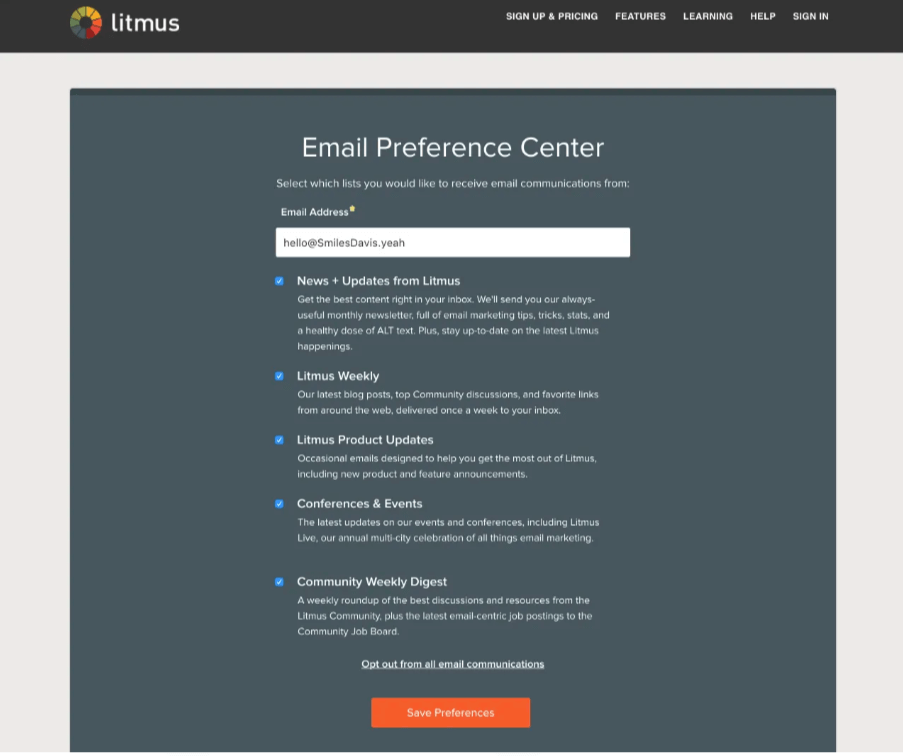
How email testing service Litmus lets subscribers manage their preferences (Source: Really Good Emails)
Personalization and segmentation are powerful techniques that can significantly enhance the effectiveness of your email marketing campaigns. When you create content thinking of specific needs and preferences, you can boost open rates, click-through rates, and ultimately, revenue.
Segmentation involves dividing your email list into smaller groups based on certain criteria, such as demographics, interests, or behaviors. This allows you to send targeted content to each group, making sure that your newsletters are relevant and engaging to all subscribers.
You can learn about your audience’s interests and preferences from several different sources. Firstly, you can infer what they are based on subscribers' interactions online (like what emails they open, what links they click, and which pages they visit).
But the most sure-fire way? Just ask them. This direct interaction is super easy with a newsletter. To get started, add some checkboxes to your newsletter sign-up form and ask your subscribers which topics they're most interested in receiving emails about.
You can also send out a survey or feedback form asking them about their interests, preferences, or any improvements they'd like to see in your emails. (Some platforms, like MailerLite, even include survey builders as part of their feature set.)
Personalization, on the other hand, involves using customer data to create individualized messages for each subscriber. You can address your subscribers by name and tailor your content to their specific preferences, creating a more customized and engaging experience.
Studies have shown that personalized emails can boost revenues by up to 15%, making this technique a game-changer for your newsletter marketing efforts.
6. Sending Newsletters at the Right Time
When it comes to email newsletters, timing can be everything. The success of your campaigns can hinge on when your subscribers receive your email. If your newsletter arrives at the wrong time, it could get lost in a cluttered inbox, reducing open rates and engagement.
Here are a few tips about finding the best sending time for your newsletter:
- Know Your Audience: Again, understanding your audience's behavior is key. If your subscribers are working professionals, they might be more likely to check their emails first thing in the morning, during lunch breaks, or after work. If your target audience is students, their email-checking habits may be entirely different.
- Test Different Times: The best way to find out the optimal sending time is to test. Divide your email list into segments and send the same email at different times, then analyze which one gets the most opens and engagement.
- Consider Time Zones: If your audience is spread across different time zones, this can complicate things a bit. You might need to segment your audience based on location and adjust your send times accordingly.
- Weekdays vs. Weekends: While weekdays are generally seen as the best days to send emails, don't rule out weekends. Some studies have found that open rates can be higher on weekends when people have more free time to check their emails. This, again, depends on your audience and requires testing.
- Frequency Matters Too: Apart from the send time, how often you send emails also impacts your campaign's success. If you send too many, you risk annoying your subscribers. If you send too few, they might forget about you. Find a balance that keeps your subscribers engaged without overwhelming them. Allowing subscribers to choose their preferred frequency (for example, via a preference center) can be a great way to achieve this.
7. Integrating Social Media and Influencer Marketing
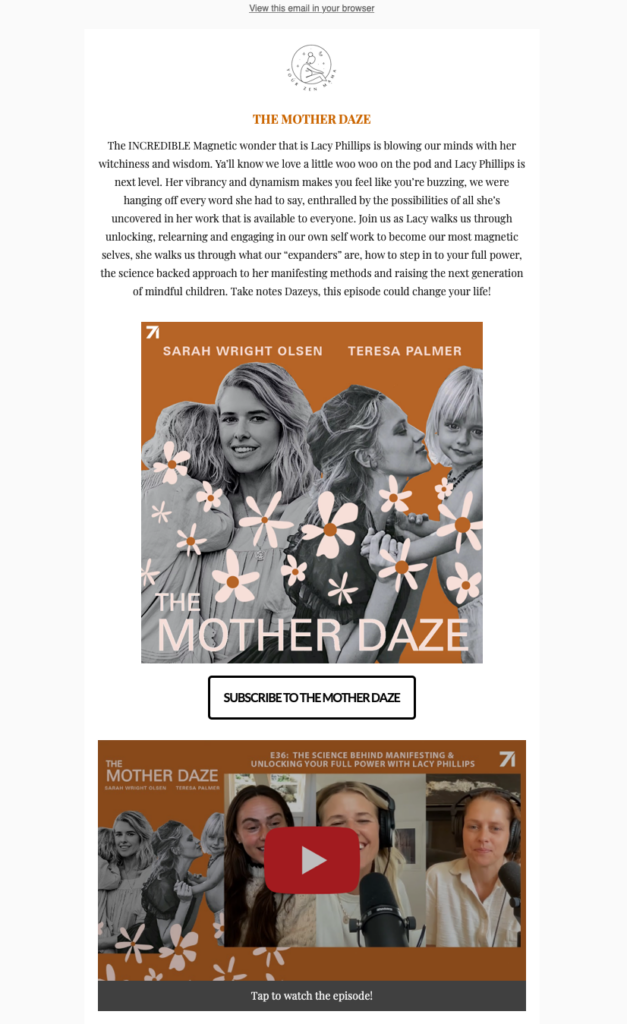
Parenthood podcasters The Mother Daze regularly promote guest speakers in their newsletters
Social media marketing and influencer marketing are a perfect combo that can benefit your overall email marketing strategy. Integrating both channels is a good move to help you expand your reach and interact with your audience on multiple platforms. This not only helps drive new subscribers to your newsletter but also reinforces your brand's presence across various touchpoints.
To effectively integrate social media and influencer marketing, start by sharing your newsletter content on your social media channels. Encourage your followers to sign up for your newsletter by promoting the benefits of subscribing and providing a clear call-to-action.
Additionally, collaborate with influencers in your industry to create content that appeals to their audience while also promoting your newsletter. Find influencers whose values align with yours and whose audience matches your target demographic.
Ask them to contribute content to your newsletter. This can take the form of guest articles, interviews, tips, or even exclusive offers for their followers. This unique content not only adds value to your newsletter but also incentivizes the influencer's audience to subscribe. The influencers can then promote this exclusive content on their social media channels, driving their followers to your newsletter sign-up page.
Remember, the key to successful integration is to ensure consistency in your messaging and branding across all platforms. A unified brand identity combined with great content makes subscribers more likely to engage with your brand both on social media and through your newsletters.
8. Analyzing and Optimizing Your Newsletter Performance
Tracking your email marketing KPIs and analyzing your newsletter performance is essential for continuous improvement and success. By keeping a close eye on key metrics such as open rate, click-through rate, unsubscribe rate, bounce rate, and email list size and growth, you can gain valuable insights into the effectiveness of your email marketing efforts.
Using these insights, you can identify areas for improvement and make data-driven decisions to optimize your newsletter strategy. For example, if you notice a high unsubscribe rate, you might consider adjusting your email frequency or reevaluating your content strategy.
Or, if your open rates are low, you might experiment with different subject lines or send times to see what works best.
Remember, consistent analysis and optimization are the keys to long-term success in newsletter marketing. Don’t underestimate the power of monitoring your performance and making necessary adjustments. This is the only way you can make your newsletters shine and drive tangible results for your business.
9. Choosing the Right Email Service Providers
Selecting the right email service provider (ESP) is an essential component of a successful email marketing strategy. With numerous options available, it's crucial to consider factors such as features, user experience, cost, data security, reviews, terms of service, and privacy policy when making your decision.
Popular ESPs such as MailerLite, ActiveCampaign, and Brevo (formerly Sendinblue) offer a wide range of features and capabilities, including easy-to-use interfaces, robust automation and analytics tools, and high deliverability rates. These providers also prioritize data security and compliance, ensuring that your email marketing campaigns are both effective and adhere to industry best practices.
Ultimately, the right ESP for your business will depend on your unique needs and goals. By carefully evaluating your options, you can select a provider that aligns with your marketing objectives and enables you to create engaging and high-performing newsletters.
10. Legal Compliance and Best Practices
Adhering to legal compliance and best practices is also crucial for the success of your email marketing campaigns. There are two parts to this:
- Making sure that you always have express consent from users, including checkboxes and disclaimers on all signup forms
- Follow regulations such as the CAN-SPAM Act and GDPR, which helps to maintain trust and avoid potential fines or penalties.
Express consent is particularly important, as it demonstrates that users are aware of the emails they're receiving and have explicitly agreed to receive them. By obtaining express consent, you can ensure that your email marketing efforts comply with the law and respect the preferences of your subscribers.
In addition to legal compliance, following industry best practices such as providing clear unsubscribe options, maintaining a clean and up-to-date contact list, and prioritizing email deliverability can help guarantee the success of your newsletter marketing efforts.
If you keep these guidelines in mind, you can build trust with your audience and enjoy the full potential of your email marketing campaigns.
Advanced Tactics for Newsletter Success
So far, we’ve talked about the fundamentals of a successful newsletter marketing strategy. To take your newsletter marketing to the next level, make good use of these advanced tactics:
- A/B Testing: This involves sending different variations of an email to a small subset of your subscribers to determine which version performs best. By A/B testing elements such as subject lines, email copy, images, and calls-to-action, you can gain valuable insights that can inform your future campaigns and improve their performance.
- Trigger-based campaigns: These are a series of automated marketing emails sent to subscribers based on specific actions they take (such as clicking links in your email), ensuring that your communication remains relevant and timely. With a good marketing automation strategy, you can effectively nurture customer relationships and guide subscribers through the sales cycle.
- Lead scoring: Subscribers who regularly open or click your emails may be more likely to turn into customers. Scoring leads and assigning points to subscribers’ actions can help your sales teams focus on leads that are ready to buy.
- Monetization: Email newsletters can provide additional revenue streams. One option is to include sponsored content or ads from relevant brands who pay to be featured. You can also earn commissions by including affiliate links to products or services you recommend. Another idea is to offer exclusive content to subscribers who upgrade to a paid membership, giving them access to valuable resources, in-depth articles, and special deals. These are just a few strategies to monetize your newsletter and generate income.
Newsletter Marketing Strategy: Summary
Creating a newsletter is a fairly easy process, but crafting a successful newsletter marketing strategy demands a thoughtful and well-rounded approach. In a world filled with endless streams of content, you need to try your best to create newsletters that not only stand out but genuinely connect with your audience.
Creativity is your starting point. Be it in the form of engaging copy, eye-catching visuals, or compelling storytelling, your ability to capture the attention of your audience is directly tied to your creative spark. Have fun experimenting with different formats before you decide on the best option for your business.
At the same time, remember that in an era where data is the new gold, leveraging it to guide your decisions is vital. Analyzing your newsletter performance data such as open rates, click-through rates, and engagement metrics will provide invaluable insights. This information helps in refining your approach, tailoring your content, and enhancing your overall strategy to yield better results.
However, success in newsletter marketing isn't a one-time feat. It's an ongoing journey that requires continuous improvement. Commit yourself to regularly analyzing your results, testing new approaches, and fine-tuning your strategy based on the insights you gather. Remember, every newsletter you send is an opportunity to learn more about your audience and improve your future efforts.
As you stay committed to this process of analysis and optimization, you're bound to see your newsletter marketing efforts flourish. You'll not only achieve your marketing objectives but also build a loyal community around your brand.
Here's to watching your newsletters fly high and making a significant impact in 2024 and beyond!
> Get started with your newsletter marketing strategy with our guide on how to create an email newsletter
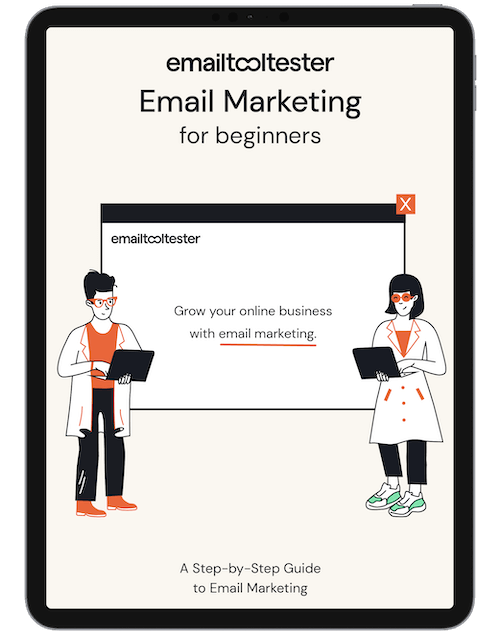
Email Marketing: Beginners Guide
Ideal for small & medium-sized businesses, online stores and bloggers. Avoid common mistakes with this complete guide.
Sign up to receive your free copy!
Our Methodology
This article has been written and researched following our EmailTooltester methodology.
Our Methodology